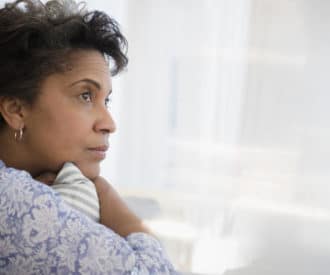
This past year has intensified anxiety, stress, and isolation for seniors and family caregivers alike. We asked experts Dr. Robin Smith, from The Oprah Winfrey Show, and Lisa Marsh Ryerson, AARP Foundation President, to answer 7 top questions about managing anxiety, stress, isolation, and depression as we emerge from the COVID-19 pandemic.
1. How can seniors and family caregivers manage anxiety as they re-enter the new normal of post-pandemic life?
Dr. Robin Smith, Therapist-in-Residence on The Oprah Winfrey Show: COVID-19 has been a traumatic time for us all, and these feelings of trauma will not immediately go away when the world reopens.
The pandemic forced many people into social isolation, but for millions of Americans – especially adults 50-plus – their isolation began long before the pandemic, and will continue after it ends.
It’s important to understand that these feelings of fear or anxiety are normal. We often consider vulnerability a weakness, but to move forward, the first step is to normalize not being ok.
People who are hesitant to emerge from quarantine into post-pandemic life should start small.
By taking manageable steps that can be accomplished, people can begin to feel progress at a slow but steady pace.
It is important not to be overly ambitious, and as each incremental step is successful, it will gradually decrease the feelings of anxiety and isolation.
2. Family caregivers have been under tremendous stress this past year. How can we manage the higher-than-usual levels of burnout and fatigue?
Lisa Marsh Ryerson, AARP Foundation President: Family and friends are the backbones of America's care system, providing the bulk of caregiving for older people in the U.S, as they strive to live independently.
The stress of this past year has made it even more challenging to balance the needs of older family members with our own households, but there are steps people can take to handle burnout and fatigue.
First, practice self-care even if only in very small ways.
Next, caregivers should check to see if their employer offers paid caregiving leave, flexible scheduling, or other benefits to help them stay in the workforce while caring for a loved one as many companies expanded these benefits during the pandemic.
3. How can family caregivers help older adults manage feelings of depression caused by the isolation of this past year?
Lisa Marsh Ryerson: AARP Foundation and United Health Foundation’s study, The Pandemic Effect: A Social Isolation Report, found that six in 10 adults 50-plus with low income are experiencing social isolation and 66% of people felt the pandemic caused their anxiety to increase.
Acknowledging that social isolation has reached epidemic proportions during the past year, we launched Connect2Affect.org to help people assess their risk and find support services.
Connect2Affect offers several resources that are especially beneficial to those caring for people in assisted living and nursing homes, including a Social Isolation Risk Assessment to help determine how connected their loved ones are, and which resources would benefit them most.
There is also a private, 24/7 Chatbot designed to provide friendly conversation to help rebuild social connections.
Maintaining regular communication, whether virtual or in-person, with seniors is the easiest way to reduce feelings of depression and isolation. Setting a recurring calendar invite daily, weekly, or bi-weekly ensures there aren’t long lapses in time between interactions.
AARP offers a number of resources for family caregivers to help connect their loved ones to local services, find advice on work-life balance, manage care at home, find support, and more.
4. What else can we do to improve our well-being right now?
Dr. Robin: It’s so important during this time that people practice self-care and take time to check-in with themselves and their loved ones.
Additionally, it’s important to check-in and evaluate your own emotions. Being anxious is different from being paralyzed by anxiety.
Many normal feelings have become manifested in abnormal ways, including the inability to feel hopeful, resourceful, or manage connections.
Identifying this is the first step to getting help.
When it comes to self-care tips, the key is to take small and manageable steps. This can help us feel progress at a slow but steady pace.
Try journaling at the end of each day and noting how different activities help you feel more connected.
Listening to music, taking a short, socially distanced walk to your neighborhood coffee shop, or spending time at the dog park (it’s ok to go even if you don’t have a pet!) are great ways to relieve stress.
This can help people feel more connected and take some time for themselves.
5. Social isolation has been an issue for many seniors even before the pandemic started. As COVID-19 restrictions lift, how can we support those who will continue to struggle with social isolation?
Lisa Marsh Ryerson: While AARP Foundation has been focused on social isolation for more than a decade, raising awareness of and offering remedies for its serious effects on both mental and physical health is even more critical as we begin to return to work, social gatherings, and the routines of daily life.
For people who are more vulnerable and need to continue to follow stay-at-home orders, we have bolstered our existing resources to help them cope with the effects of prolonged social isolation.
At Connect2Affect.org, we offer resources to help people stay connected, like a search function so they can type in a ZIP code and get connected to help right in their local neighborhood or community.
6. Now that COVID-19 vaccines are available, will social isolation decrease?
Dr. Robin: Not right away. Even as states lift COVID-19 restrictions and millions of people are vaccinated, some people are still very nervous about reentering social circles and workplaces, and they remain isolated.
A recent University of Michigan poll found about one in five adults 50 and over said their overall mental health was worse since the pandemic started, and they currently experience depression, anxiety, insomnia, substance use, or another mental health disorder.
The mental toll of isolation is real.
It’s important to overcome the stigma of admitting to being socially isolated and seek treatment for mental health and support.
There is no reason to be ashamed of feelings that come with the territory of being fully human…strong and fragile all at the same time.
During this very challenging time, we are doing the best we can in any given moment. Give yourself credit for your resilience, courage and heart.
7. Why is social isolation a growing concern?
Lisa Marsh Ryerson: Social isolation can have a long-term impact on not only mental health but also physical health, including an increased risk of heart disease, dementia, cognitive decline, high blood pressure, or sleep disorders.
Studies have found that isolation and loneliness are worse for health than obesity, and that prolonged isolation is comparable to smoking 15 cigarettes a day.
Physical distancing and stay-at-home orders, while necessary to stop the spread of COVID-19 to save lives, led to an increase in isolation and loneliness for many older adults who were disconnected from their family, friends and community.
Recommended for you:
- 10 Ways to Help Seniors Deal with Isolation and Depression
- Best Way to Make Video Calls to Seniors with Alzheimer’s or Dementia in Nursing Homes
- How to Cope with Compassion Fatigue: 8 Tips for Caregivers
Guest contributors: Dr. Robin Smith, best known as the Therapist-in-Residence on The Oprah Winfrey Show, is a licensed Psychologist and ordained minister with a Ph.D. in Counseling Psychology. An experienced media and television personality, she is the author of several books including a New York Times #1 best-seller.
Lisa Marsh Ryerson is president of AARP Foundation, the charitable affiliate of AARP. She sets the Foundation’s strategic direction and steers its efforts toward a country free of poverty, where no older person feels vulnerable. Under her leadership, AARP Foundation has secured unprecedented funding to support programs and services that truly change lives.
This article wasn’t sponsored and doesn’t contain affiliate links. For more information, see How We Make Money.
[optin-monster slug=”yxbytm35zhsdfopnw7qk”][optin-monster slug=”jvhyplxmb4umsjazxecn”]




